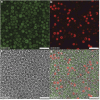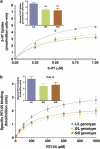Differential serotonin transport is linked to the rh5-HTTLPR in peripheral blood cells
- PMID: 22832814
- PMCID: PMC3309549
- DOI: 10.1038/tp.2012.2
Differential serotonin transport is linked to the rh5-HTTLPR in peripheral blood cells
Abstract
The human serotonin transporter (SERT) gene possesses a 43-base pair (bp) insertion-deletion promoter polymorphism, the h5-HTTLPR. Genotype at this locus correlates with variation in anxiety-related personality traits and risk for major depressive disorder in many studies. Yet, the complex effects of the h5-HTTLPR, in combination with closely associated single-nucleotide polymorphisms (SNPs), continue to be debated. Moreover, although SERT is of high clinical significance, transporter function in vivo remains difficult to assess. Rhesus express a promoter polymorphism related to the h5-HTTLPR. The rh5-HTTLPR has been linked to differences in stress-related behavior and cognitive flexibility, although allelic variations in serotonin uptake have not been investigated. We studied the serotonin system as it relates to the 5-HTTLPR in rhesus peripheral blood cells. Sequencing of the rh5-HTTLPR revealed a 23-bp insertion, which is somewhat longer than originally reported. Consistent with previous reports, no SNPs in the rh5-HTTLPR and surrounding genomic regions were detected in the individuals studied. Reductions in serotonin uptake rates, cell surface SERT binding, and 5-hydroxyindoleacetic acid/serotonin ratios, but not SERT mRNA levels, were associated with the rh5-HTTLPR short allele. Thus, serotonin uptake rates are differentiable with respect to the 5-HTTLPR in an easily accessible native peripheral tissue. In light of these findings, we foresee that primary blood cells, in combination with high sensitivity functional measurements enabled by chronoamperometry, will be important for investigating alterations in serotonin uptake associated with genetic variability and antidepressant responsiveness in humans.
Figures





References
-
- Lesch KP, Bengel D, Heils A, Sabol SZ, Greenberg BD, Petri S, et al. Association of anxiety-related traits with a polymorphism in the serotonin transporter gene regulatory region. Science. 1996;274:1527–1531. - PubMed
-
- Wendland JR, Martin BJ, Kruse MR, Lesch KP, Murphy DL. Simultaneous genotyping of four functional loci of human SLC6A4, with a reappraisal of 5-HTTLPR and rs25531. Mol Psychiatry. 2006;11:224–226. - PubMed
-
- Wendland JR, Moya PR, Kruse MR, Ren-Patterson RF, Jensen CL, Timpano KR, et al. A novel, putative gain-of-function haplotype at SLC6A4 associates with obsessive-compulsive disorder. Hum Mol Genet. 2008;17:717–723. - PubMed
-
- Sen S, Burmeister M, Ghosh D. Meta-analysis of the association between a serotonin transporter promoter polymorphism (5-HTTLPR) and anxiety-related personality traits. Am J Med Genet B Neuropsychiatr Genet. 2004;127B:85–89. - PubMed

